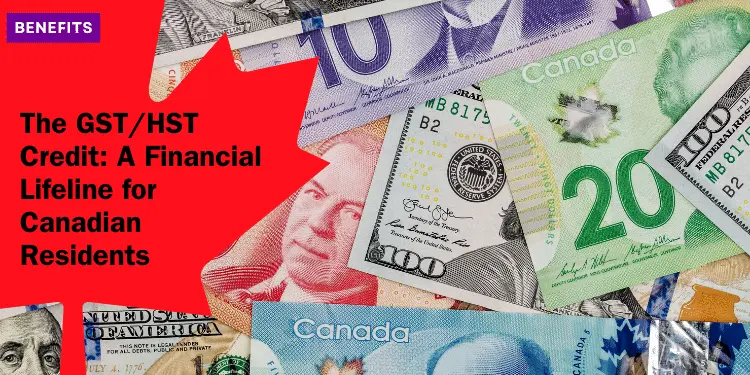The GST/HST Credit: A Financial Lifeline for Canadian Residents

Anúncios
Welcome to an informative journey through the financial support system available to Canadian residents, specifically the GST/HST credit.
This tax-free quarterly payment plays a crucial role in the lives of individuals and families with low to modest incomes, offering a much-needed financial lifeline.
By helping offset the cost of the federal goods and services tax (GST) or harmonized sales tax (HST), this credit is essential in ensuring that essential goods and services remain affordable despite the added tax burden.
For many individuals and families across Canada, the GST/HST credit serves as a valuable resource that helps alleviate the financial pressures caused by rising costs.
Whether it’s purchasing everyday necessities, paying for medical treatments, or managing housing expenses, the credit makes it easier for those living on a fixed or lower income to manage their household budget without compromising their quality of life.
The reality of modern-day living is that even basic services and goods are subject to taxes that can create additional financial strain on households with limited resources. The GST/HST credit provides a buffer against these strains.
In the following sections, we will dive deeper into the essence of the GST/HST credit, explaining how it works and how it can benefit you.
Understanding this benefit can make a significant difference in managing your finances, as well as ensuring you’re receiving the financial support you’re entitled to.
With a proper understanding of the program, you can maximize your benefits and better plan for the future, giving you the confidence to take control of your financial situation.
Explanation of the GST/HST Credit
The GST/HST credit is a government initiative designed to assist individuals and families who bear the financial burden of paying the GST or HST on their purchases.
These taxes, while necessary to fund various public services and infrastructure, can disproportionately impact those with lower incomes.
For individuals and families living on modest incomes, the GST/HST credit provides crucial financial relief, ensuring they are not overwhelmed by the added tax burden.
It’s a measure designed to address the regressive nature of sales taxes, where lower-income groups typically spend a larger portion of their income on taxable goods and services.
✅ How It Works
The credit is intended to offset the cost of the GST/HST, which is a consumption tax that applies to most goods and services in Canada.
While it doesn’t eliminate the tax altogether, it significantly reduces the financial strain on low-income individuals and families.
This relief is particularly important when considering the high cost of living in many parts of the country, especially in urban centers.
With this credit, the government aims to ensure that people with lower incomes are not disproportionately impacted by the added costs associated with consumption taxes.
By providing this financial cushion, the government helps to make everyday goods and services more affordable, enabling families to better manage their household budgets.
The credit amount varies based on several factors, including your income, family size, and whether you have a spouse or common-law partner.
The GST/HST credit is calculated annually, and each year, the government adjusts the payment amounts to reflect changes in inflation and the cost of living.
These adjustments ensure that the credit remains effective and continues to provide real financial relief to those who need it most.
As the cost of living rises, the credit can help mitigate some of the negative impacts on family budgets, especially for those who live on fixed incomes.
✅ Eligibility for the GST/HST Credit
To be eligible for the GST/HST credit, you must be a Canadian resident and file a tax return with the Canada Revenue Agency (CRA). Even if you don’t have taxable income, filing your return is necessary to determine whether you qualify for the credit.
This ensures that the government has the necessary information to assess your eligibility based on your income, family situation, and other factors.
The CRA uses your income from the previous tax year to determine your eligibility for the GST/HST credit.
This means that it’s crucial to file your tax returns on time each year to ensure that your eligibility is assessed correctly and that you receive the maximum credit amount available to you.
By providing accurate information, you ensure that the CRA can properly evaluate your need for the credit and make sure the amount is correct.
If your income or family size changes, you may be eligible for a different amount in the following year, so staying current with your tax filings is essential.
Assistance Available for Canadian Residents in Need
The government recognizes that some individuals face challenging circumstances that may affect their ability to access or manage their financial benefits.
If you find yourself in a situation where you are leaving an abusive or unsafe environment, there are provisions in place to help you receive your GST/HST credit payments safely and securely.
The safety of Canadians is paramount, and the government has created specific safeguards to ensure that your benefits are still accessible without compromising your security.
✅ Safety Provisions
The Canada Revenue Agency (CRA) offers mechanisms to ensure that you can continue receiving your GST/HST credit payments without compromising your safety.
This includes providing alternative communication methods, secure payment options, and privacy safeguards.
For instance, if you’re in a vulnerable situation, you can contact the CRA to make arrangements for receiving payments securely.
Whether through alternative payment methods or private communication, the CRA strives to keep your information protected.
Additionally, if you’re a parent in a shared custody arrangement, you can still receive half of the credit for your child. This ensures that financial support reaches the child, regardless of the parents’ living arrangements.
Shared custody arrangements can sometimes complicate the distribution of financial support, but the government has made sure that the benefits are fair and equitable for all parties involved.
Payment and Dates
GST/HST credit payments are typically issued on the fifth day of the months of July, October, January, and April.
These quarterly payments provide consistent support throughout the year, helping recipients manage their finances more effectively.
The regularity of these payments means that recipients can count on receiving financial assistance at predictable intervals, making it easier to plan household budgets and avoid financial strain.
This regular schedule ensures that families and individuals can better align their expenses with their income, creating more financial stability.
✅ What to Do if Payments Are Delayed
If you haven’t received your payment on the expected date, the CRA recommends waiting up to 10 business days before contacting them.
This waiting period accounts for potential postal delays or any processing issues that may arise. Since delays can sometimes happen, the CRA allows this buffer period before taking action.
If after 10 days you still haven’t received your payment, it’s important to reach out to the CRA to resolve the issue. In many cases, delays can be traced back to postal issues or administrative processes, but it’s always good to follow up to ensure that there are no mistakes.
Maintaining Updated Information with the CRA
To ensure that you’re receiving the correct GST/HST credit amount, it’s crucial to keep your personal and financial information updated with the CRA.
Any changes in your income, marital status, or family size can affect your eligibility for the credit and the amount you’re entitled to.
If your situation changes—such as getting married, having a child, or experiencing a drop in income—updating the CRA with this new information ensures that your benefits remain accurate.
By submitting accurate tax returns on time and keeping the CRA informed of any changes in your circumstances, you can ensure that your benefit payments are correctly adjusted and reflect your current situation.
In conclusion, the GST/HST credit plays a significant role in helping to alleviate the financial burden that taxes place on low-income households.
By providing financial relief through quarterly payments, the program makes it easier for Canadians to afford essential goods and services.
It is a critical support system for many, helping them navigate the rising costs of living and ensuring that they are able to maintain their quality of life.
Understanding the eligibility requirements, payment schedules, and available support mechanisms will help you make the most of this valuable financial resource.
With a deeper understanding of the program, you can better manage your financial situation and ensure that you’re getting the full benefits you’re entitled to.






